 |
Diamond is nuclear physicists' best friend
|
 |
Steady Gains Being Made in 12 GeV Upgrade Project: Civil-Construction Design Work Underway for Hall D Facility
|
 |
Innovative energy-saving process pays off for Jefferson Lab cryogenics team
|
 |
The Test Lab is getting better and safer
|
 |
Pursuit of a Ph.D. leads from Tel Aviv to Hall A
|
 |
'In their own words' with Phil Adderley of the JLab Center for Injectors and Sources
|
 |
Use extra care in the summer months to avoid wild pests and poisonous creatures
|
 |
Help make community, JLab a nicer place to live, work: Join Adopt-A-Spot
|
 |
JLab evening lectures range from Ben Franklin to sailing
|
 |
Milestones mid-May through mid-June 2007 |
Diamond is nuclear physicists’ best friend (top ^)
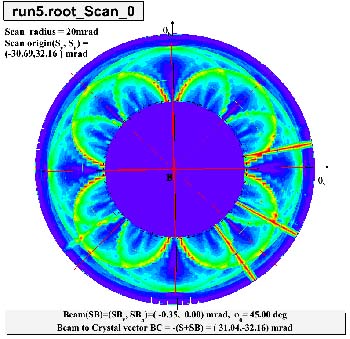
To make a graph of the diamond’s alignment, the goniometer rotated it in a full circle.
A brilliant diamond shining in Jefferson Lab’s Experimental Hall B is providing nuclear physicists with some dazzling results.
The physicists spent long hours studying the diamond’s bright sparkle, but they weren’t learning the basics of diamond buying. Instead, they were trying to verify the alignment of a window-pane-like, thin slice of diamond. The diamond is part of a system for providing polarized photon beams–very precise beams of polarized photons that are oriented in the same direction–for experiments.
"This diamond is as close to perfect as we can get. It's a very thin sliver of diamond, about 5 mm wide," says Ken Livingston, a visiting scientist from Glasgow University and a principal member of the team that built a so-called diamond radiator system. Other institutions that collaborated in the system’s development were: George Washington University, Catholic University, Idaho State University, Arizona State University and Jefferson Lab.
Shining light on a diamond causes it to sparkle. A diamond also will sparkle if struck by a beam of electrons, such as those produced by Jefferson Lab's CEBAF accelerator. When electrons pass through the diamond, some are diverted and emit photons. "If you have the diamond oriented correctly, it produces a linearly polarized photon beam. The plane of all the photons is the same, instead of their being oriented randomly," Livingston explained.
A device called a goniometer tilts the diamond, much like a jeweler turning an engagement ring to admire its sparkle. "We have to make sure that we have the diamond pointing in the correct direction in relation to the beam," Livingston said.
The goniometer is precise to hundredths of a degree. In comparison, the second hand of a watch sweeps through six degrees with each second. Were a watch to measure seconds with the same accuracy as the goniometer, it would vibrate 600 times to move the same space swept through by a second hand in one second.
To make a graph of the diamond’s alignment, the goniometer rotated it in a full circle. The diamond was exposed to about one second of electron beam for each of 180 steps. Bright red dots on the graph corresponded to each exposure. Except for three bright red lines indicating instances where the electron beam tripped off, the graph showed a perfectly aligned diamond.
Steady Gains Being Made in 12 GeV Upgrade Project: Civil-Construction Design Work Underway for Hall D Facility (top ^)
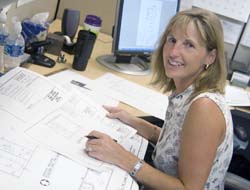
12 GeV Upgrade Civil Associate Project Manager Rebecca Yasky prepares to review Hall D complex designs.
“We’re making steady progress,” is Civil Associate Project Manager Rebecca Yasky’s message regarding planning for the design and civil construction of the Hall D facility portion of the 12 GeV CEBAF Upgrade project.
Since being reassigned to the 12 GeV CEBAF Upgrade project from the Facilities Management department in the fall of 2004, Yasky has turned her attention to the challenge of leading the design teams of conventional facilities for the 12 GeV CEBAF Upgrade, where cutting-edge science will take place.
Design work for the Hall D building and supporting infrastructure started in January 2006 when the architectural and engineering firm of Hayes, Seay, Mattern & Mattern from Roanoke, Va., was contracted to develop the design documents. The Commonwealth of Virginia provided funding in 2006 and 2007 to support this design effort.
It was imperative to begin design work on the Hall D building and infrastructure at that time, Yasky explained, to minimize potential schedule delays to the overall 12 GeV CEBAF Upgrade project.
“It‘s going to take a year to build the Hall D facility,” she said, “which is separate from the time that will be needed to build the experimental equipment for the new hall. We needed to be ahead of the curve on the facility design work in order to be ready for construction work when the funding becomes available.”
The Southeastern Universities Research Association is gifting approximately 6.9 acres on the northeast end of the current Lab property to DOE to be used as part of the $12.5 million Hall D complex. The construction will include the hall, a counting house, a stand-alone cryogenics plant, a service building, utilities, roads and clearing the land. The entire 12 GeV CEBAF Upgrade is expected to cost about $306 million and will enable CEBAF’s world-wide user community to greatly expand its research horizons, and allow breakthrough programs to be launched in several key areas.
This summer, a retention pond will be created on the land, although it is not directly a part of the complex, Yasky explained. The pond is a requirement of the Chesapeake Bay Preservation Act and fits with plans for various future developments in that area.
The civil design work for Hall D is complicated by the fact that the scientific equipment is also currently under design, presenting a challenge for designers and requiring a high level of teamwork among the three 12 GeV groups: civil, accelerator and physics.
“We work closely with the Hall D physics group,” she explained, “to ensure that the building we construct meets their operational needs.”
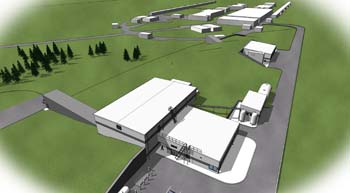
This architectural rendering shows the Hall D complex to be built as part of the CEBAF 12 GeV Upgrade at Jefferson Lab.
Every element of the new experimental equipment -- still at the preliminary design stage, and much of it enormous -- has to be taken into consideration not only for operations but also installation in the Hall D complex. For instance, a proposed entryway into the underground tunnel has been revised to accommodate a 13-meter-long vacuum box that has to go into the tunnel as a single piece. The original entrance was perpendicular to the tunnel section. “Obviously, there was no way we were going to fit that box around a 90-degree turn,” Yasky said. The entrance now comes in at a diagonal angle.
The existing halls are being used as lessons-learned for resolving issues and design optimization. Hall B is the most similar to the planned operations at Hall D. One of the major differences for Hall D, is that, in the other halls, the tunnel runs directly into the hall; for Hall D, the photon beam will be carried to Hall D via a buried pipe.
Two reviews of the 12 GeV CEBAF Upgrade project are planned for this summer, which will lead to Critical Decision Two (CD-2), and establish the baseline of scope, schedule and budget against which all future work will be judged. When CD-2 is awarded, the project will go to final, or definitive, design. Additionally, a peer review of the civil design of the Hall D complex was held on May 7, when a committee of two physicists and a structural engineer from other DOE laboratories reviewed the plan. The reviewers gave JLab “two thumbs up” and concluded that the physics requirements for the civil design have been identified and are being incorporated into the Hall D civil plans. The proposed date to break ground for Hall D is 2009, with civil construction commencing later that year.
“I can’t give enough praise to the people in all the elements of this project,” Yasky said. “Most of the people involved are matrixed to this endeavor, so they are doing their regular jobs along with this one. Everyone is working very hard as a team. If we didn’t have the great team work, we wouldn’t have any success.”
Innovative energy-saving process pays off for Jefferson Lab cryogenics team (top ^)
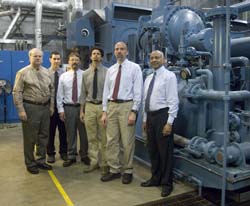
The Jefferson Lab engineers who received a White House Closing the Circle Award were (left to right): Cryogenics Group Leader Dana Arenius, and team members Mathew Wright, Jonathan Creel, Kelly Dixon, Peter Knudsen and Venkatarao “Rao” Ganni.
A series of innovative energy-saving processes invented by a team of Cryogenics Group engineers at Jefferson Lab were celebrated with a prestigious White House Closing the Circle Award during ceremonies on June 12, 2007, in Washington, D.C.
The engineers revolutionized the way helium cryogenic (refrigeration) plants work, reducing electricity consumption at Jefferson Lab and other Department of Energy scientific research facilities. The new processes require very few or no new components and nearly double the lifetime of refrigeration equipment, while improving system reliability, availability, stability and efficiency.
The benefits of the combined processes will be fully realized with the construction of new facilities, but portions of the processes have already been demonstrated on existing systems with significant results, including the Relativistic Heavy Ion Collider at Brookhaven National Laboratory in Upton, N.Y., and the Spallation Neutron Source at Oak Ridge National Laboratory in Oak Ridge, Tenn.
At Jefferson Lab, an existing refrigeration system was reconfigured to allow compressors to automatically scale back when full capacity isn't needed. This process slashed the power requirements of the refrigeration system from 6 megawatts to 4.2 megawatts, resulting in a savings of $33,000 each month. The change also increased the time between necessary maintenance periods for the compressors from 45,000 hours to 74,000 hours.
The team also fully automated Jefferson Lab's refrigeration facilities, the first cryogenics plant to do so, using a computer-based control system for round-the-clock load-matching efficient operation without the need for round-the-clock staffing.
Jefferson Lab's Continuous Electron Beam Accelerator Facility uses superconducting niobium cavities to accelerate electrons for nuclear physics experiments. To do this, the Lab cryogenically cools the cavities to between -452 and -456 degrees Fahrenheit with liquid helium, which causes the metal to become superconducting–resulting in close to zero electrical resistance in the metal.
The Jefferson Lab team who received the Closing the Circle Award included: Cryogenics Group Leader Dana Arenius, and team members Jonathan Creel, Kelly Dixon, Venkatarao “Rao” Ganni, Peter Knudsen and Mathew Wright.
White House Closing the Circle Awards are presented to those federal employees and their facilities whose efforts have resulted in significant contributions to or significant positive impact on environmental stewardship. The awards are competitively selected and presented annually through the Office of the Federal Environmental Executive (editors note: The OFEE is now the Office of Federal Sustainability (OFS)) . A total of just 17 awards were presented during the June 12 ceremony held at the Office of the Federal Environmental Executive. Department of Energy activities earned four of the 10 awards given in the civilian category.
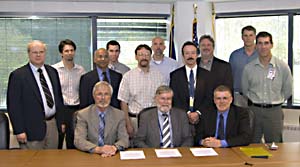
In late-April, a team of six from the Cryo group (far left, back and middle rows) was recognized by Department of Energy Site Office representatives Scott Mallette and Steve Neilson (middle row, right) with the DOE Office of Science Pollution Prevention and Environmental Stewardship Best in Class award. At that time Lab Director Christoph Leemann (front, from left) and Technology Transfer Manager Jim Boyce signed a licensing agreement for use of JLab’s new cryogenic processes with John Urbin (front, right), from Linde BOC Process Plants, LLC. Also attending the ceremony were Chief Financial Officer Joe Scarcello, and Will Oren, head of the Engineering Division (back row, right).
“The Cryogenics Group is very proud to have provided a contribution to Jefferson Lab’s commitment to energy savings and to reducing the Lab’s overall environmental impact,” comments Group Leader Dana Arenius.
When the advancement was first announced in 2006, DOE Associate Director of the Office of Science's Office of Nuclear Physics, Dennis Kovar, praised the Cryogenics Group's energy-saving efforts. "Cryogenics improvement could have a positive impact,” he said, “on all superconducting radiofrequency facilities now and in the future."
Other facilities are now working with the Jefferson Lab Cryogenics Group to reduce their cryogenic electricity requirements by implementing as many of the processes as are feasible. The processes have been submitted to the U.S. Patent Office for review and a patent is pending.
In March, the Cryogenics team’s efforts earned a DOE Office of Science Pollution Prevention and Environmental Stewardship Best in Class award for 2006. The award recognized the team’s efforts at making a considerable energy savings to the running of accelerator cryogenics plants. The award promotes and recognizes outstanding environmental management performance at DOE’s 10 national laboratories and highlights innovative programs and individuals.
On April 25, John Urbin, representing the Cryogenic Plants and Services Division of Linde BOC Process Plants, LLC, signed a 10-year license with Jefferson Science Associates, LLC/Jefferson Lab to use the processes developed by Jefferson Lab’s Cryogenics team in building new commercial plants and upgrading older refrigeration facilities.
This accomplishment was first reported in September 2006.
The Test Lab is getting better and safer (top ^)
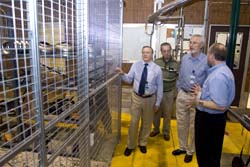
Recently, Jefferson Lab Director Christoph Leemann and DOE Site Manager James A. Turi toured the Test Lab with Andrew Hutton, associate director for accelerators. Here Bob Bennett, building manager, and Bob Rimmer, director of the Superconducting Radiofrequency Institute, show Turi (far left) and Leemann a new component storage area.
Workers at the Test Lab are not only pushing the frontiers of accelerator design these days, they are also pushing brooms, wielding paint brushes and doing whatever else is necessary to create a safer and more orderly work environment.
Walls have been painted, new storage facilities installed, piles of materials neatly stacked and office space reorganized, just to name a few of the changes that been made since the clean-up effort began in March.
“It’s gratifying to see how people have embraced this continuous improvement project,” says Andrew Hutton, the associate director for accelerators, and whose idea it was to launch the project. “The results have been remarkable, and there is no doubt that the Test Lab is a safer and healthier place to work. And what’s exciting is that there’s even more to come.”
The project has specific goals, such as: creating space by using external storage; eliminating unused and unneeded items; cleaning up and organizing work areas; painting, carpeting and repairing common office areas and high-bay and exterior walls; and improving the overall work environment.
Technicians Mike Beck and Ken Baggett not only cleaned up and organized their area, they also added a personal touch. They refurbished their shared office space by painting the walls white and adding a border around the ceiling in the colors of their favorite football team–the Washington Redskins.
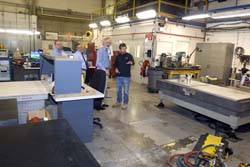
Technician Mike Beck tells Lab Director Christoph Leemann about the refurbishment work underway in the Test Lab's magnet test area.
“We went ahead and bought some paint,” Beck said. “We figured, ‘Hey, we’re not going to get contractors in here. We’ll go ahead and do it ourselves.’ We painted the floors and the walls.”
“We spend a lot of time working in here,” Beck explained, “We wanted to refurbish and brighten up the Magnet Measurement facility. I couldn’t think of a better way to do so than by showing some ‘Redskin Pride’.”
Late last month, Jefferson Lab Director Christoph Leemann and DOE Site Manager James A. Turi toured the Test Lab with Hutton, while Bob Rimmer, director of the SRF Institute, and Bob Bennett, building manager, served as tour guides. Rimmer and Bennett showed off the many improvements that also included new carpet in the conference room and office hallways, as well as rearranged partitions in the copy/print area that reduced clutter and created more open space.
“I am delighted with the new look of the Test Lab; our people did a fantastic job in improving their environment in a way that will enhance safety, quality, productivity, and quality of life. Congratulations,” Leemann said.
“The progress made by Bob Bennett, Bob Rimmer and the Test Lab staff is a visible commitment to workplace safety and quality,” Turi added. “They have set a high standard for others.”
Future projects include a renovated lobby, a reconfiguration of the lapping room, additional cooling for the CryoUnit Assembly Room, repairs to condensation leaks in AHU-4, a balancing of room temperatures in the RF Test Lab (279), and a noise abatement program.
Pursuit of a Ph.D. leads from Tel Aviv to Hall A (top ^)
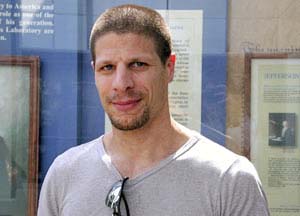
Guy Ron, a Hall A visiting scientist, has returned to Jefferson Lab to finish his current research project.
Users at Jefferson Lab come from all over the world. Some move to the United States for a few years while completing their research. Today though, many international physicists who come to the Lab for its unique research capabilities don’t stay for the duration of their projects. Such is the case for physicist Guy Ron, a user from Tel Aviv University in Israel, currently working on his Ph.D.
Young physicist named Adams Fellow and winner of Dothan PrizeÂ
In late May, Guy Ron was named an Adams Fellow and will begin his fellowship in October. The Adams Fellowships Program provides financial assistance to outstanding doctoral students in the exact sciences, mathematics and the life sciences. The program was established jointly by Marcel Adams of Canada and the Israel Academy of Sciences and Humanities in 2005. The fellowships are granted annually to up to 10 graduate students at the beginning of their doctoral studies, for a period of up to four consecutive years. Candidates are proposed by their institutions and usually have completed the first year of study before receiving the fellowship, either on a direct doctoral track or after completion of a second degree.
“It's great,” Ron says. “It's nice to be noticed for the science that you do, and it allows me a lot of opportunities that otherwise I probably would not have had.”
Ron also recently received the Dothan Prize, awarded for excellence in research by graduate students in particle physics. The prize, announced in April, is offered in memory of Professor Yossef Dothan of Tel Aviv University.
Ron majored in physics in high school and knew then he had found his passion. Even after taking seven years off from school to serve in the Israeli Army, Ron’s interest in science persisted. At 25, he began his undergraduate studies at Tel Aviv, and the following summer he took advantage of an opportunity to participate in a Department of Energy undergraduate research program now called the Science Undergraduate Laboratory Internships program. His supervisor for the internship was Hall A’s Bogdan Wojtsekhowski.
Ron learned of the opportunity from Eli Piasetzky, a physics professor at Tel Aviv and a researcher at Jefferson Lab. For two months, Ron worked on the same project as Piasetzky. He kept in touch with Piasetzky throughout his undergraduate career and came to Jefferson Lab for research again following his initial visit. After completing his bachelor’s degree in physics, Ron returned to the Israeli Army to serve an additional three years, in return for a fully funded university education. While serving in the Army, Ron was able to take a few classes, and continued correspondence with the professor. Ron also maintained his role in a research setting, taking an occasional week of absence to continue his work at Jefferson Lab.
After finishing his time in the army, Ron recalls, “It was pretty obvious that I’d end up doing my graduate work with Eli as my thesis adviser.” Ron returned to complete additional research at Jefferson Lab and his professional relationship with Piasetzky supported his goals. In addition, Ron explains, “This Lab has opportunities in nuclear physics which don’t exist elsewhere because of the capabilities of the accelerator. We don’t have accelerators in Israel that can perform fundamental nuclear physics on an experimental basis like the accelerator at Jefferson Lab.”
The research he has been working on in Hall A requires a fairly low energy, and focuses on measuring how the polarization of the photon is transferred to the proton as the nucleus breaks up. “We’re scanning the energy range, and doing the measurements to allow the theorists to refine the theory,” he explains.
His research has been performed in collaboration with a team, including another Ph.D. student, Jackie Glister. Technologies such as phone conferencing and e-mail make research collaboration possible, even from across the world, a convenience not available even 20 years ago.
While he performs his research in the United States, he has yet to experience a formal education in an American setting. Despite the fact that he has not taken a class in the United States, he notes, “You learn a lot here, because you’re interacting with the physicists here, just nothing formal.”
Ron has finished nearly all of classes needed for his Ph.D.; and he is currently completing thesis. In spite of the great focus Ron has on his academic and research goals, he believes in being well rounded. “It’s important to have broad horizons,” he says. He makes time to do things outside of physics, including running, teaching Chinese martial arts, and paragliding in Israel.
“Sound mind in a sound body,” Ron remarks, “a lot of ideas come to you when you’re in a completely different setting.”
‘In their own words’ with Phil Adderley of the JLab Center for Injectors and Sources (top ^)
as told to Judi Tull
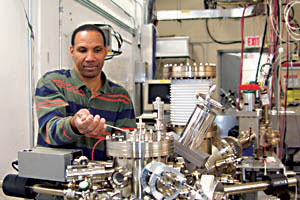
Phil Adderley, an Accelerator Division Injector and Sources team member, works on system components.
I think my life was changed–and my career set for me–during my junior year in high school when my woodworking teacher showed us a bi-metallic strip. It was that moment when I started to think about how things work. I realized that once you ask that question, you get answers, but you also get more questions.
I am a native of the Bahamas and went through public school there. In 6th grade, we took the entrance exam for high school and I scored well enough to be admitted to my high school of choice, Government High, which was considered the best of the public schools. I excelled academically and also in sports. I was a very well-rounded athlete; I played softball and soccer, threw the javelin and pole-vaulted. My dad was a Baptist minister and a carpenter. He built houses from scratch, and during the summer I worked with him building houses. That certainly kept me in shape for being an athlete! He encouraged me to pursue architecture and I intended to do that. When I graduated from high school, I felt like I was ready to take on the world.
I’d hoped to go to McGill University in Montreal, but my older brother, had gotten a full ride at Morehouse College, and my parents insisted that I go where he was. I was able to get a combination of track and academic scholarships, but Morehouse did not offer a major in architecture and so I switched to physics.
It was at Morehouse that I learned so much about the struggle of African Americans in the United States. In fact, Dr. Martin Luther King’s son, Dexter, and Spike Lee were classmates of mine.
I finished my bachelor’s in physics at Morehouse and then went to work at Fermi Lab in the summer of 1980. That summer was so rewarding; I learned a lot and met a lot of people in the accelerator field. Working there helped put my academic studies in place; this was the place that made it all concrete.
Although I went back to Atlanta University to begin work on my graduate studies, I was offered a full-time job at Fermi. This was a huge moment for me, and I took it. I had the opportunity to work with my hands, and I have always been an avid maker of things. I quickly rose to the position of Technologist II at Fermi, building magnets for the accelerator and learning vacuum technology.
In January 1988, I applied for a position here, and despite a hiring freeze, was hired and began work in October of that year. I’m currently with the Injector and Sources Team, constructing the electron gun and making the vacuum good or better. We expect to install the new version of the polarized electron gun around this summer.
One of the things that affected me most profoundly as a young man was that all my teachers were passionate about their fields. I believe so strongly that young people need mentors and role models. As a result, I was involved in the Lab’s ATOMS (Adventures in Technology Options in Math or Science) program from its inception. We went to area schools to do demonstrations of practical physics, to engage students in what the field is about. I was also one of the first technicians to volunteer with the Becoming Enthusiastic About Math and Science program.
Since I’ve been here, I also helped start a Black History program, although for funding reasons for the last few years, we haven’t been as active as we would have liked. I’ve also recently become involved in the effort to make Fort Monroe a national park, something that I think is particularly important because it is truly where slavery ended in America when, in 1861, the commander of the fort gave refuge to three escaped slaves, declaring them “contraband.”
My wife, Jennifer, works at Canon and our son, Andrew, has played middle- and high school basketball. He also shows a particular interest in engineering and computer science.
I love my job here, but I know that if I were to leave the Lab tomorrow, I would become a teacher and go into science education. I think it is that important to the lives of our young people.
Use extra care in the summer months to avoid wild pests and poisonous creatures (top ^)
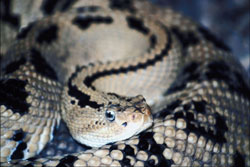
Facilities Management urges everyone to take extra care when working in areas that mimic the natural habitat of dangerous creatures.
The Jefferson Lab site plays host to a variety of “picturesque” wildlife, including goldfinches, white-tailed deer and groundhogs. On the flip side, dangerous critters can also be present, including black widow spiders, rattlesnakes and stinging wasps. Facilities Management urges everyone to take extra care when working in areas that mimic the natural habitat of these creatures.
Natural and manmade areas in and around JLab provide ideal habitat for several types of wild critters. Some, like piping plovers and muskrats, are fun to watch and are careful not to let you get too close. Other creatures, however, are not so harmless and often lurk in dark crevices or may even be found out in the open, hidden by natural camouflage.
For instance, the dark corners in storage rooms and industrial areas and the shade and privacy provided by the many above-ground pipes may shelter spiders, including the poisonous brown recluse and black widow. Overhanging eaves on buildings may harbor the nests of stinging wasps, and snakes of all varieties may blend in with the natural landscape or even be found out in the open–soaking in the sun’s rays or residing in one of our drainage ditches.
Facilities Management urges everyone at JLab–and especially those working on the Accelerator Site–to take extra precautions during the summer months, when such creatures are most active. If you should come across any of these or other potentially dangerous animals, alert Mike Lewellen at ext. 7169 or lewellen@jlab.org, so that Facilities Management can safely remove any infestations.
There are also a number of common-sense tips that you can use to protect yourself from encounters with undesirable critters, including:
- Never reach into a dark area. Always fully illuminate the area and check for pests, sharp objects, electrical and other hazards.
- Be extra careful around all pipes and under the gas-flow handles on gas-storage bottles.
- Avoid and report areas where stinging insects are present, such as bees, wasps and biting flies.
- Be observant of asphalt, concrete slabs and wide metal pipes, which provide warm spots for snakes to sun themselves.
- Stay clear of tall grasses, water in ditches, and rotting wood, which can hide snakes and ticks and other potential hazards such as holes.
The Centers for Disease Control and other reputable websites have additional information on avoiding and handling insect stings, tick bites, spiders, snakes, and other vermin.
Help make community, JLab a nicer place to live, work: Join Adopt-A-Spot (top ^)
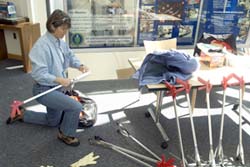
Volunteer today to be Jefferson Lab’s first Adopt-A-Spot coordinator. Newport News provides equipment for Adopt-A-Spot volunteers. Here Mary Jo Bailey, from the Environment, Safety, Health and Quality Division, preps gear for the Lab’s April Earth Day 2007 trash pick up.
Interest has been expressed recently regarding Jefferson Lab participating in the voluntary Adopt-A-Spot program managed by the City of Newport News Public Works Department. But before Jefferson Lab can make the two-year commitment to the program, a volunteer team coordinator must be named, according to JLab Environmental Engineer Linda Even.
The volunteer coordinator must be able to coordinate with the Newport News Public Works Department to get the resources that the city provides for Adopt-A-Spot volunteers. The coordinator also will plan and organize the quarterly roadside litter patrols, which will include individual volunteers and any Jefferson Lab Activities Group teams that elect to participate in this community support endeavor.
The public streets that will be included in the Adopt-A-Spot commitment haven’t been specified yet, but could include:
- Jefferson Ave., from Onnes Dr. up to Oyster Point (both sides of street)
- Oyster Point, from Jefferson Avenue to Canon Blvd. (south side of street)
- Canon Blvd., from Achievement Way to Middle Ground (both sides of street)
The streets to be included in the commitment will be studied by the volunteer coordinator and Linda Even. At this time, it is anticipated that volunteers will be able to perform this community service during their lunch hours, after work or on weekends, according to Even. The Public Works Department provides safety vests, litter grabbers, gloves and trash bags for Adopt-A-Spot volunteers.
“This is an ideal opportunity to give back to our community,” Even says. “The coordinator can use this volunteer position to build or improve their organizational and communication skills, and offer them the opportunity to network with people from across the Laboratory as well as with city employees.”
Anyone interested in volunteering for the coordinator position may contact Linda Even, ext. 7308, or email lle@jlab.org. Even will be the link between the coordinator and the JLab Environmental Management Systems Committee and senior management.
For more information about the Newport News Adopt-A-Spot program, contact Even or visit the NN Public Works Adopt-A-Spot website.
JLab evening lectures range from Ben Franklin to sailing (top ^)
In conjunction with the Jefferson Lab Annual Users Group Meeting, the Lab is hosting two evening lectures. The Monday, June 18, presentation highlights the genius and scientific discoveries of Benjamin Franklin. By establishing that lightning is electrical and that electricity involves charge, Franklin’s research opened the way for many new discoveries. Fred Dylla, executive director and CEO of the American Institute of Physics and former Jefferson Lab associate director, discusses how Franklin helped light the way to countless modern applications, from cathode-ray and photomultiplier tubes, to large systems for electrical power distribution, to the continuing evolution of particle accelerators.
The next night, Tuesday, June 19, Bryon Anderson, author and professor of physics at Kent State University, will discuss the physics of sailing, including the hull speed limit, frictional forces, Bernoulli's principle applied to both the keel and the sails, and vortex generation from the keel and sails. He will explain the advantages of sailing upwind or downwind with different sail configurations and advances made in hull, keel, and sail designs made possible by an improved understanding of the underlying physics.
Each presentation begins at 8 p.m. in Jefferson Lab's CEBAF Center auditorium, located at 12000 Jefferson Ave., Newport News, Va. The programs are free and open to anyone interested in learning more about science and last about one hour, including a question-and-answer period at the end. For security purposes, enter at Jefferson Lab's main entrance (Onnes Dr.). Everyone over 16 is asked to carry a photo ID. Security guards may perform ID, backpack, purse and vehicle checks. Call 757-269-5102 for more information.
Milestones mid-May through mid-June 2007 (top ^)
Hello
Vitaly Baturin, 12 GeV Upgrade Research Scientist, Physics Division
David Carlson, Electrical Engineering Student Intern, Engineering Division
Saul Cohen, Post Doctoral Associate, Information Technology Division (Started March 16, 2007, not previously announced)
Marissa Fazenbaker, Staff Secretary, Accelerator Division
Stacy Harden, Staff Secretary, Accelerator Division
Robert Lewis, Student Intern, Accelerator Division
William Richard, Radio Frequency Technician, Engineering Division
Alexander “Sasha” Stolin, Detector & Imaging Group Post Doc Associate, Physics Division (Started March 16, 2007, not previously announced)
Mark Todd, Electronics Technician, Engineering Division
Garrett Tompkins, Computer Engineering Student Intern, Free-Electron Laser Division
Christine Wheeler, Science Education Administrator, Director’s Office
Goodbye
Allen Ellis, Mechanical CAD Designer, Engineering Division
Doyle Erwin, Shipping Clerk, Facilities & Logistics Management
Richard Evans, FEL Instrumentation Engineer, Free-Electron Laser Division
Michael Haddox-Schatz, Scientific Computing Programmer, Information Technology Division
John Mammosser, Staff Engineer–Superconducting Radio Frequency, Accelerator Division
Christopher Miller, Computer Center Student Intern, Information Technology Division
Ethan O'Toole, Systems Administrator, Information Technology Division
Julie Oyer, Project Management Administrator, Project Management & Integration
Katherine Phillips, Student Intern, Physics Division
Ronnie Smith, Tool Crib Attendant, Engineering Division
Matthew Stokes, FEL I&C Group Student Intern, Free-Electron Laser Division
These Milestone entries, listed alphabetically, are actions posted by Human Resources from mid-May through mid-June 2007. Current JLab Career Opportunities are posted at: https://careers.peopleclick.com/careerscp/client_jeffersonlab/external/search.do

